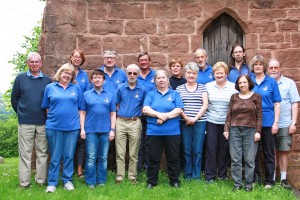Like most towers, the Kingston upon Thames ringers has an outing each year. In odd-numbered years it is usually a day outing, and in even numbered years we make a week-end of it. This year we were mainly in Herefordshire and Gloucestershire, with brief forays into Wales.
All three towers on Friday were in Wales, first the 12 at Newport Cathedral. With several of our regular ringers unable to join us we were not entirely up to strength for 12-bell ringing, but with the assistance of two Newport ringers, we were able to ring a course of Stedman Cinques and Little Bob Maximus on this lovely 12. In contrast, the bells at Tregare (5, 8 cwt) were, shall we say, “challenging”. The ringers of 4 and 5 could not see each other because there was a large cupboard in the way; when ringing up, 1 and 2 didn’t strike until the bells stood; and the third tended to drop like a stone if not very carefully nurtured. We did just about manage a plain course of Stedman Doubles. Our last tower on Friday, Dingestow, seemed easy in comparison, although there was a lot of noise from upstairs due to a sticking pulley. We rang a selection of Doubles and Minor methods.
The Saturday tour started at Staunton (6, 9¾ cwt, rung from the middle of the church). These are nice bells and we did them reasonable credit with Cambridge Minor and Stedman Doubles. Next was English Bicknor (6, 7½ cwt) which is a fine Norman church. We successfully rang a course of Norwich Surprise. Goodrich (6, 10 cwt) are another nice ring which we put to good use with several methods including Oxford Treble Bob. At Weston-under-Penyard (6, 10 cwt) we had a good raise. These are tuneful bells on which we rang Double Oxford and Stedman.
Lunch was at the New Harp in Hoarwithy, a quiet village with an interesting church (although without bells). King’s Caple bells are hard work (several are still on plain bearings) but were worth the effort. We rang Grandsire Doubles, Bob Minor and had a good lower. Bridstow (8, 8¾ cwt) were a nice ring and we did them reasonable credit with Double Norwich, Yorkshire and Stedman.
The last tower of the day was at Ross on Wye (8, 20 cwt), a very enjoyable ring although they seemed to go a bit slowly for their weight. We rang a full course of Cambridge, touch of Stedman, and had a good lower.
Sunday started with service ringing in Monmouth (8, 16¾ cwt) a fine ring to which we did reasonable credit with Stedman, Grandsire and another good lower. We then had time for a coffee break at Henry’s café where there was a table arrangement that was almost a feature of the week-end – one long table with a small round one at the end, a bit like an exclamation mark!
At Newland (6, 16¼ cwt) there was the slightly unusual arrangement that the treble needed a box, but the tenor didn’t! We were warned that the 2nd and the 5th had a tendency to go up “wrong”: the 2nd did indeed go up wrong but the local who met us put that right very efficiently. We rang Cambridge and a touch of Plain and Little on these sonorous bells.
The last tower of our tour was Lydney (10, 13½ cwt) where we rang among other things a good 2 course touch of Stedman and had a good 10-bell lower. We could hear the whistles from the local steam trains in the distance. Lunch was at the Cross Inn at Aylburton where we were well looked after. Our thanks are due to Paul and Kate Flavell for making all the arrangements and to all the tower representatives for meeting us and making us welcome.
